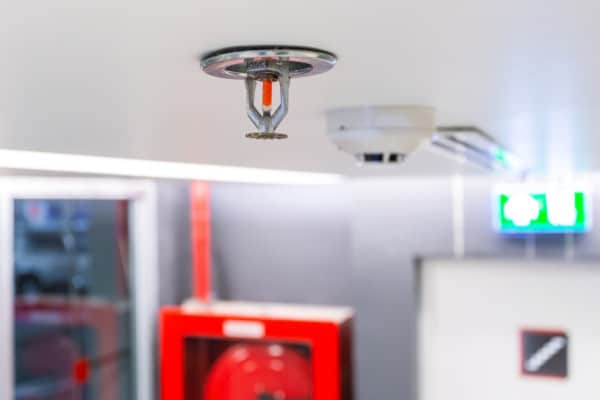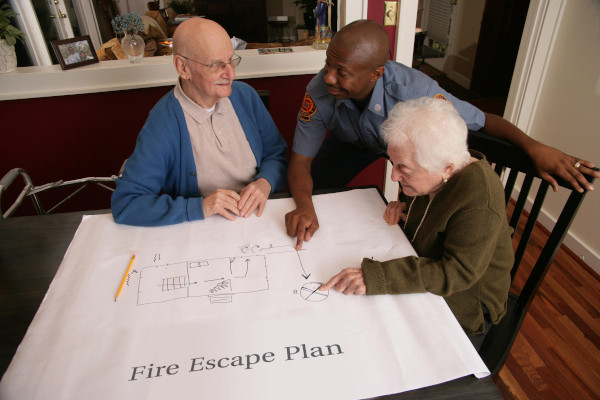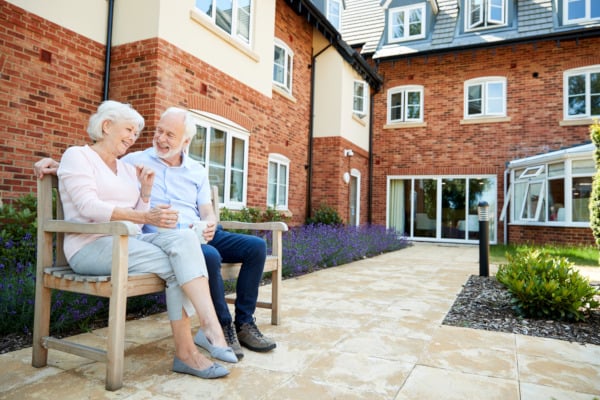The NFPA and ICC requirements that keep seniors and buildings fire safe
Fire departments in the US respond to more than 1,800 fires within residential board and care facilities annually, including senior housing facilities. Given this number of fires, you might expect a high number of deaths and injuries, as well. But 88% of these blazes do not spread beyond the area of origin because of stringent code requirements for fully functional fire sprinkler and detection systems.
A great example of the effectiveness of fire sprinklers in residential board and care facilities was a sprinkler save that happened in June at the Victory Centre of Park Forest in Illinois. A single fire sprinkler activated to control a fire that started when a senior resident left a stovetop unattended. The resident was unharmed, and “none of the other 94 apartments received any damage or any other reported injuries.”
Check out QRFS’s companion blog to learn more about this sprinkler save and the unique threats posed by cooking fires and poorly maintained fire protection systems. And to learn about the codes and standards that keep these facilities safe, read on!
Fire protection starts with defining the occupancy type
The Victory Park fire could have turned out a lot different without adequate fire protection, and that safety begins with correctly identifying and defining a building’s occupancy use and type. When it comes to senior housing and care facilities, two primary model codes published by the National Fire Protection Association (NFPA) and the International Code Council (ICC) each have distinct definitions for this type of facility.
NFPA model code
NFPA 101: Life Safety Code defines this type of structure as a “residential board and care” occupancy:
From the 2021 edition of NFPA 101
3.3.196.12* Residential Board and Care Occupancy.
An occupancy used for lodging and boarding of four or more residents, not related by blood or marriage to the owners or operators, for the purpose of providing personal care services. (SAF-BCF)
NFPA 101’s section on residential board and care facilities further divides these occupancies into small facilities, large facilities, and apartment buildings:
- A small facility provides accommodations for 16 or fewer people
- A large facility provides care and accommodations for more than 16 people
- Residential board and care apartment buildings are facilities made up of three or more units, each unit having its own independent bathroom and kitchen.
Each of these sub-classifications has specific fire protection and life safety requirements in NFPA 101.
ICC model code
The ICC’s International Building Code (IBC) defines larger examples of these occupancies (more than 16 people) as a Group I, Institutional Occupancy. In addition, and more specifically, spaces used for residential board and care are classified as a Group I-1:
From the 2018 edition of the IBC
Institutional Group I-1
Institutional Group I-1 occupancy shall include buildings, structures or portions thereof for more than 16 persons, excluding staff, who reside on a 24-hour basis in a supervised environment and receive custodial care. Buildings of Group I-1 shall be classified as one of the occupancy conditions specified in Section 308.2.1 or 308.2.2. This group shall include, but not be limited to, the following:
- Alcohol and drug centers
- Assisted living facilities
- Congregate care facilities
- Group homes
- Halfway houses
- Residential board and care facilities
- Social rehabilitation facilities
The IBC further delineates I-1 occupancy types into Condition 1 or Condition 2. Condition 1 occupancies are those in which the occupants do not need any assistance with building evacuation. In Condition 2 facilities, the occupants will require some help.
In contrast, smaller residential board and care facilities that house six to 16 persons are classified by the IBC as residential Group R-4. And where no more than five persons are accommodated, the facility is classified as a residential Group R-3.
The Victory Centre facility from the story mentioned above has 174 apartments that are a mix of “79 supportive living apartments for adults 65 and over and 95 independent living apartments for adults 62 and over.” Thus the International Building Code regards it as a Group I-1 (more than 16 people) and likely Condition 2 (some of those people require evacuation assistance) facility.
In contrast, NFPA 101 classifies it as an Apartment Building (three or more units with independent kitchens and bathrooms) suitable for Residential Board and Care (four or more residents, not related by blood or marriage to the owners or operators, for the purpose of providing personal care services).
Knowing these classifications ensures that the proper fire protection systems are installed.
The state of Illinois, where the aforementioned fire happened, uses the IBC model code as the basis for its legally enforceable codes. Model codes are written by NFPA and ICC and broadly adopted by state and local governments, but often with specific omissions and amendments. For example, buildings within Cook County, IL, must adhere to locally adopted versions of the 2021 editions of the International Building Code and International Fire Code (IFC)). And Group I-1 occupancies follow the IBC and IFC guidelines for required fire protection systems.

Fire protection system requirements in the I-Codes and NFPA model codes
The proper and interactive function of specific fire protection systems is needed to ensure a safe environment for residents in senior facilities. And the systems required or potentially required by NFPA and ICC in these occupancies include fire sprinklers, fire alarms, kitchen hood systems, fire extinguishers, fire-rated barriers, and smoke detectors.
Though the ICC’s International Building Code and International Fire Code are pretty straightforward about the fire protection needs in senior facilities, determining what’s needed according to NFPA 101 requires a bit more digging through the code. For example, when a residential board and care facility is considered an apartment building, additional fire protection requirements are found in “Chapter 30: New Apartment Buildings.” These rules are on top of the items found in Section 32.2 (“Small Facilities”) that govern individual apartments’ requirements, such as egress and interior finishes.
Here is a rundown of the essential fire protection system needs, with a focus on more extensive facilities like Victory Park.
Fire sprinkler systems in senior housing
The International Fire Code requires installing an automatic fire sprinkler system throughout a Group I-1, Condition 2 building according to the most stringent rules found in NFPA 13: Standard for the Installation of Sprinkler Systems. The more exhaustive requirements for this type of system stem from the fact that residents may have trouble evacuating.
In contrast, if a facility is a Group I-1, Condition 1, owners can install a less complex residential sprinkler system following the rules in NFPA 13R: Standard for the Installation of Sprinkler Systems in Low-Rise Residential Occupancies. A 13R system is permitted instead of an NFPA 13 system because occupants do not need evacuation assistance.
NFPA 101 has similar sprinkler requirements throughout small facilities, large facilities, and apartment buildings, with a caveat. If a structure is four stories or fewer and does not exceed 60 feet above grade, NFPA 101 allows owners to install an NFPA 13R system rather than an NFPA 13 system. Additionally, any areas of the building considered hazardous such as boiler rooms, employee locker rooms, laundry facilities, and trash collection rooms, must also be separated by a one-hour-rated fire barrier.
Kitchen hood systems
Kitchens in Group I-1 facilities must be protected with hood systems installed following the provisions of section 420.8 of the IBC. The protection must consist of an automatic fire-extinguishing system that’s purpose-built for cooking safety. These systems are typically pre-engineered, and UL 300A listed and installed. That said, where senior housing is classified as an apartment building, individual building units are not required to have a hood suppression system.
Fire extinguishers in senior housing and facilities
All relevant NFPA and ICC codes require fire extinguishers installed throughout the structure and within 30 feet of cooking equipment. The selection, installation, and maintenance of extinguishers should be done per the rules in NFPA 10: Standard for Portable Fire Extinguishers.
Fire alarm and smoke detection systems
A fire alarm and smoke detection system is also required throughout most buildings by both NFPA and ICC codes. However, there is an exception that allows pull stations to be eliminated from the sleeping areas of individual units. And chapter 30 of NFPA 101 does not require a fire alarm system unless the facility exceeds 11 units and is four or more stories in height. But section 32.2 does require manual fire alarm pull stations in each residential board and care unit when a complete fire alarm system is needed.

Emergency planning and preparedness considerations
Group I-1 occupancies must have a fire safety and evacuation plan as outlined in chapter 4 of the IFC, including the items in section 404. This chapter details emergency plans, drills, and training, and a plan should include specific employee actions and resident procedures.
Both employees and residents must be trained on the fire safety and evacuation plan’s components. Drills for employees and residents should be conducted at least semi-annually for all shifts, and each exit should be utilized during these exercises. The same requirements for an emergency action plan are stated in section 32.7 of NFPA 101, but NFPA specifies a more frequent bi-monthly drill plan.
Fire protection ensures safe senior living and care
Residents should feel safe and comfortable living in senior housing communities or any residential board and care facilities. These settings exist to promote quality of life through independence and assistance. Worrying about inadequate fire protection should not be a concern.
Fortunately, code-compliant residential board and care facilities maintain a high degree of safety through effective fire protection systems, emergency planning, trained staff, and prepared staff and residents.
QRFS is dedicated to simplifying and promoting fire protection. If you need to purchase equipment, be sure to check out our online selection or contact us at 888-361-6662 or support@qrfs.com for assistance.




I am looking to place a piece of HVAC equipment into a service gate area at a facility. There is a Wall Post Indicator Valve at the wall within this fenced areas and was looking to see what the clearance codes for setting the equipment by this valve.
Chuck — For specific codes and standards questions like yours, you can try our Ask a Fire Pro service. Click the link to submit your question with some information about your building, and a fire protection professional will provide an answer based on best practices, standards, and codes. Our pros include AHJs, contractors, engineers, and code experts with 150+ years of combined experience!
We have a 40 apartment complex the fire alarms go off at all times of day and night and brings the fire department every time this has been going on for months all they do is disconnect something so it won’t go off limiting our protection is their state law that prohibits this unreasonable company to continue
Doing nothing
Sandra — For code questions like this, you can try our Ask a Fire Pro service. Click the link to submit your question with some information about your building and system, and a fire protection professional will provide an answer based on best practices, standards, and codes. Our pros include AHJs, contractors, engineers, and code experts with 150+ years of combined experience!
I live in an elderly complex that has 13 buildings each building has 4 apartments in it. We got a new manager and she is trying to make all of us to remove our furniture from in front of our windows in the living room saying it’s a fire hazard. We have 2 escape routes the bedroom window and the living room door. Isn’t that sufficient?
Yvonne — For code questions like this, you can try our Ask a Fire Pro service. Click the link to submit your question with some information about your building and system, and a fire protection professional will provide an answer based on best practices, standards, and codes. Our pros include AHJs, contractors, engineers, and code experts with 150+ years of combined experience!
What are the fire safety code for assistant living deadbolt locks on the outside door of the apartment?
Michael — For system, standards, and code questions like this, you can try our Ask a Fire Pro service. Click the link to submit your question with some information about your building and system, and a fire protection professional will provide an answer based on best practices, standards, and codes. Our pros include AHJs, contractors, engineers, and code experts with 150+ years of combined experience!
Do all apartments in a Seniors facility need to be fire resistant as far as the entrance door?
Unfortunately, the fire-resistant rating rules for walls, doors, and other structural elements in Ch. 7 of the International Building Code are complex and can depend on various factors; providing a definitive, researched-based answer is beyond the scope of this forum. Your best bet is to contact a registered design professional and provide them with details of the structure in question.
Can the roof axis be locked up to prevent homeless people gaining an axis.
Eric — Unfortunately, we’d need more detail regarding your question and it is better handled by a code official/authority having jurisdiction who can evaluate your circumstances. We suggest contacting your local AHJ (e.g., fire marshal) and running the scenario by them. Thanks for reading.
In an assisted living facility, if a fire alarm goes off in an apartment, should there be a trigger to the nurses station, admin area or even maintenance to know there is an active alarm?
Jodie — the rules and references you are looking for in the International Building Code, based on the exact nature of the facility in question, (IBC; assuming a local version of this applies in your area) are found in section 907.2.6. Always check with your local authority having jurisdiction (e.g., fire marshal or building official) to verify what applies to your situation.
how many elevators are required for a 3 story facility housing over 100 residents with stair ways. making access for EMT hard. The elevators are used for construction, moving people in and out and daily commuting for the residents living there. We have several calls for EMT service a month. we are due to facing a shut down from Nov. 13 – 16 for 24 hours each day until repairs are made. many residents can not walk….they use walkers or scooters / electric chairs.. being confined to their areas with food delivered to rooms only. the ground level can move about. we have no over nite security person on the premises. how can a license be given for such limited services.. we are presently going thru renovations so there is extra traffic on the elevators.
This building is at 1393 Bowles Ave in Fenton. Mo. who is the governing agent for this?
Nancy — You should contact your local government and inquire about who is the appropriate authority having jurisdiction, which may be a fire inspector or building inspector. As for the number of elevators based on the facility and their mobility, this is a fairly complex code question. You can consult a qualified life safety/fire protection professional in your area or try our Ask a Fire Pro service for an informal code interpretation. Click the link to submit your question with some information about your building, and a fire protection professional will provide a detailed answer based on standards and codes.
are independent senior living facilities covered by ifc 404 in south carolina?
Richard — We’re unsure what you referencing as “404,” but the 2021 South Carolina Building Code and the 2021 South Carolina Fire Code are based on the 2021 editions of the International Building Code (IBC) and International Fire Code (IFC), respectively. You can review the state’s codes here. Independent senior living facilities will fall under an occupancy classification. Thanks for reading and commenting.
are there any fire codes for decorating for the holidays the doors of the residents of an assisted living facility?
W — We aren’t sure without researching the codes. However, for example, there are codes specifying that occupancies like schools can only have a certain portion of their walls covered with paper (e.g., posting artwork), as that increases the fuel load in a building. Your best bet is to contact your local authority having jurisdiction (e.g., fire department or fire marshal) and seeing what they have to say. Thanks for reading.
Are electric fireplace tv stands aloud
Bob — We are not certain (and doubt the codes get this specific regarding this specific type of device). You should contact your local authority having jurisdiction (fire department/inspector) for a more definitive answer to your question. Thanks for reading!